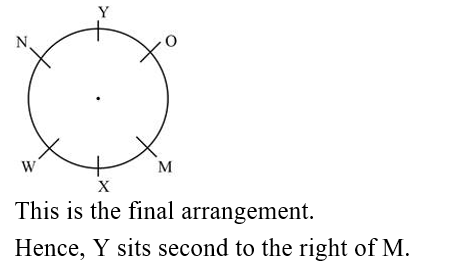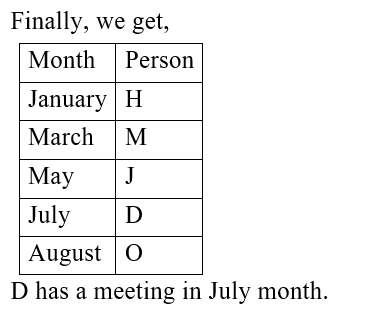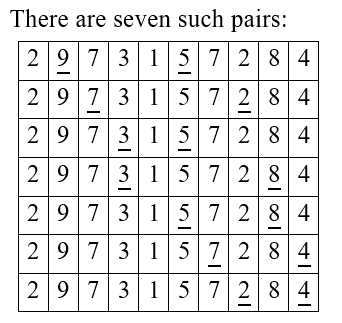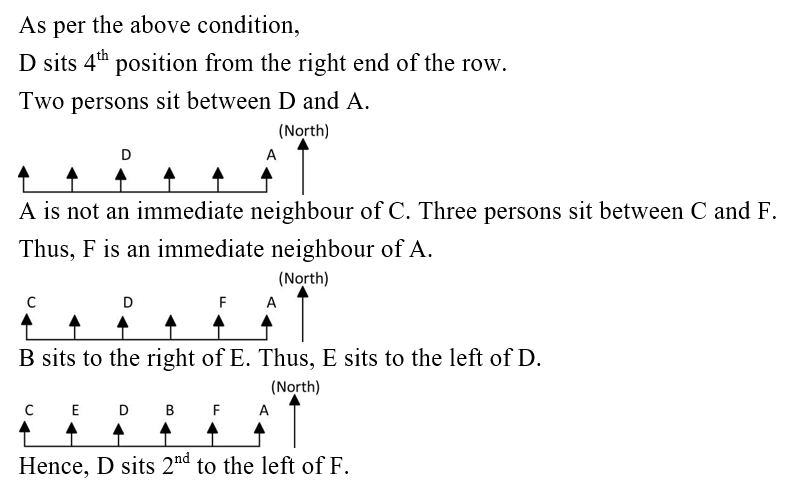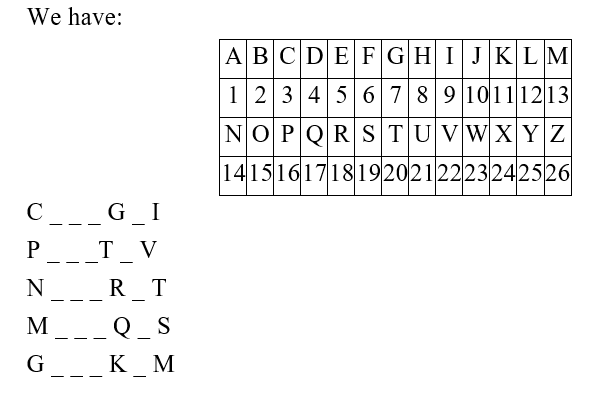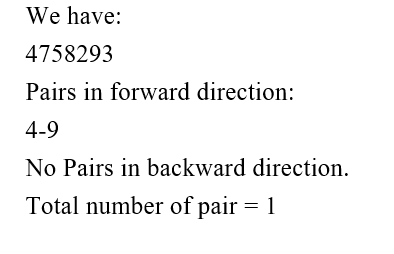Question 1:
Directions : A certain number of people are sitting in a linear row and all are facing in the north direction. B sits second from one of the extreme ends of the row. There are five people sitting in between A and B. Four people are sitting in between A and E. C sits third to the right of E. Four people are sitting in between C and D. F sits second to the right of C. D sits second from one of the extreme ends of the row. B and E are not immediate neighbors of each other.
निर्देश : एक निश्चित संख्या में लोग एक रैखिक पंक्ति में बैठे हैं और सभी उत्तर दिशा की ओर मुखरित हैं। B पंक्ति के किसी एक चरम छोर से दूसरे स्थान पर बैठा है। A और B के बीच में पाँच व्यक्ति बैठे हैं। A और E के बीच में चार व्यक्ति बैठे हैं। C, E के दाईं ओर से तीसरे स्थान पर बैठा है। C और D के बीच में चार व्यक्ति बैठे हैं। F, C के दाईं ओर से दूसरे स्थान पर बैठा है। D पंक्ति के किसी एक चरम छोर से दूसरे स्थान पर बैठता है। B और E एक दूसरे के निकटस्थ पड़ोसी नहीं हैं।
How many people are sitting in between A and C?
A और C के बीच कितने व्यक्ति बैठे हैं?
Question 2:
Directions : A certain number of people are sitting in a linear row and all are facing in the north direction. B sits second from one of the extreme ends of the row. There are five people sitting in between A and B. Four people are sitting in between A and E. C sits third to the right of E. Four people are sitting in between C and D. F sits second to the right of C. D sits second from one of the extreme ends of the row. B and E are not immediate neighbors of each other.
निर्देश : एक निश्चित संख्या में लोग एक रैखिक पंक्ति में बैठे हैं और सभी उत्तर दिशा की ओर मुखरित हैं। B पंक्ति के किसी एक चरम छोर से दूसरे स्थान पर बैठा है। A और B के बीच में पाँच व्यक्ति बैठे हैं। A और E के बीच में चार व्यक्ति बैठे हैं। C, E के दाईं ओर से तीसरे स्थान पर बैठा है। C और D के बीच में चार व्यक्ति बैठे हैं। F, C के दाईं ओर से दूसरे स्थान पर बैठा है। D पंक्ति के किसी एक चरम छोर से दूसरे स्थान पर बैठता है। B और E एक दूसरे के निकटस्थ पड़ोसी नहीं हैं।
How many people are sitting in between B and E?
B और E के बीच कितने व्यक्ति बैठे हैं?
Question 3:
Directions : A certain number of people are sitting in a linear row and all are facing in the north direction. B sits second from one of the extreme ends of the row. There are five people sitting in between A and B. Four people are sitting in between A and E. C sits third to the right of E. Four people are sitting in between C and D. F sits second to the right of C. D sits second from one of the extreme ends of the row. B and E are not immediate neighbors of each other.
निर्देश : एक निश्चित संख्या में लोग एक रैखिक पंक्ति में बैठे हैं और सभी उत्तर दिशा की ओर मुखरित हैं। B पंक्ति के किसी एक चरम छोर से दूसरे स्थान पर बैठा है। A और B के बीच में पाँच व्यक्ति बैठे हैं। A और E के बीच में चार व्यक्ति बैठे हैं। C, E के दाईं ओर से तीसरे स्थान पर बैठा है। C और D के बीच में चार व्यक्ति बैठे हैं। F, C के दाईं ओर से दूसरे स्थान पर बैठा है। D पंक्ति के किसी एक चरम छोर से दूसरे स्थान पर बैठता है। B और E एक दूसरे के निकटस्थ पड़ोसी नहीं हैं।
Who among the following sits at the second position from the extreme left end of the row?
निम्नलिखित में से कौन पंक्ति के चरम बाईं छोर से दूसरे स्थान पर बैठा है?
Question 4:
If in the word COMPLICATED, the consonants are replaced by immediate second next letter and the vowels are replaced by immediate next letter, then how many consonants are there in the newly formed word?
यदि COMPLICATED शब्द में, व्यंजन को ठीक दूसरे अगले वर्ण से प्रतिस्थापित किया जाता है और स्वर को ठीक अगले वर्ण से प्रतिस्थापित किया जाता है, तब नवनिर्मित शब्द में कितने व्यंजन हैं?
Question 5:
Study the following information and answer the given question.
निम्नलिखित जानकारी का अध्ययन करें और दिए गए प्रश्न का उत्तर दें।
Six people are seated around a circular table facing the centre. W sits immediate left of X, who sits third to the right of Y. O sits immediate right of M. N is adjacent to Y.
छह व्यक्ति एक वृत्ताकार मेज के इर्द-गिर्द केंद्र की ओर मुखरित होकर बैठे हैं। W, X के निकटस्थ बाईं ओर बैठा है तथा X, Y के दाईं ओर से तीसरे स्थान पर बैठा है। O, M के निकटस्थ दाईं ओर बैठा है। N, Y के आसन्न बैठा है।
Who sits second to the right of M?
M के दाईं ओर से दूसरे स्थान पर कौन बैठा है?
Question 6:
Five people have a meeting in five different months i.e. January, March, May, July and August, but on the same date of each month. J has a meeting before July. One person has a meeting between J and O. H has a meeting immediately before M. D has a meeting in one of the months after M. Who among the following has a meeting in July month?
पाँच व्यक्तियों की पाँच अलग-अलग महीनों अर्थात् जनवरी, मार्च, मई, जुलाई और अगस्त की समान तारीख को एक बैठक होती है। J की बैठक जुलाई से पहले किसी एक महीने में होती है। J और O के बीच में एक व्यक्ति की बैठक होती है। H की बैठक M के ठीक पहले होती है। D की बैठक M की बैठक के बाद किसी एक महीने में होती है। निम्नलिखित में से किस व्यक्ति की बैठक जुलाई महीने में होती है?
Question 7:
How many such pairs of numbers are there in 2973157284, each of which has as many digits between them as in arithmetic series?
2973157284 में संख्याओं के ऐसे कितने युग्म हैं, जिनमें से प्रत्येक के बीच उतने ही अंक हैं जितने कि अंकगणितीय श्रेणी में उनके बीच होते हैं?
Question 8:
Six persons A, B, C, D, E and F are sitting in a row and facing north direction but not necessarily in the same order. D sits 4th position from the right end of the row. Two persons sit between D and A, who is not an immediate neighbour of C. Three persons sit between C and F. B sits to the right of E. Who sits 2nd to the left of F?
छह व्यक्ति A, B, C, D, E और F एक पंक्ति में बैठे हैं और उत्तर दिशा की ओर मुखरित हैं लेकिन आवश्यक नहीं कि समान क्रम में हों। D पंक्ति के दायें अंत से चौथे स्थान पर बैठा है। D और A के बीच में दो व्यक्ति बैठे हैं और A, C का निकटस्थ पड़ोसी नहीं है। C और F के बीच में तीन व्यक्ति बैठे हैं। B, E के दायें बैठा है। F के बायें से दूसरे स्थान पर कौन बैठा है?
Question 9:
Four of the following letter pairs are similar in some manner and one is different. Find the odd one.
निम्नलिखित में से चार अक्षर युग्म किसी न किसी रूप में एक समान हैं और एक भिन्न है। असंगत ज्ञात कीजिए।
Question 10:
How many pairs of digits are there in the number '4758293' which have as many numbers between them as in the natural number series when counted from both forward and backward direction?
संख्या '4758293' में आगे और पीछे दोनों दिशाओं से गिनने पर अंकों के ऐसे कितने युग्म हैं जिनके बीच उतनी ही संख्याएँ हैं जितनी कि प्राकृतिक संख्या शृंखला में उनके बीच होती हैं?

